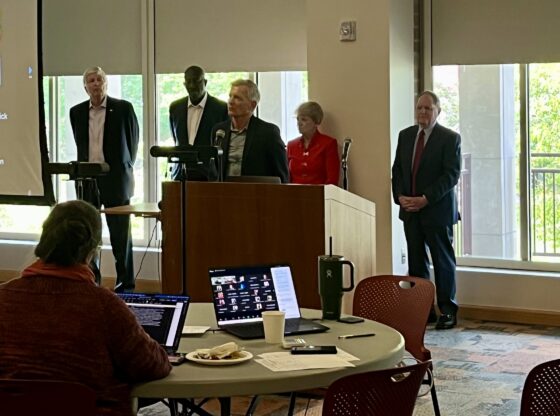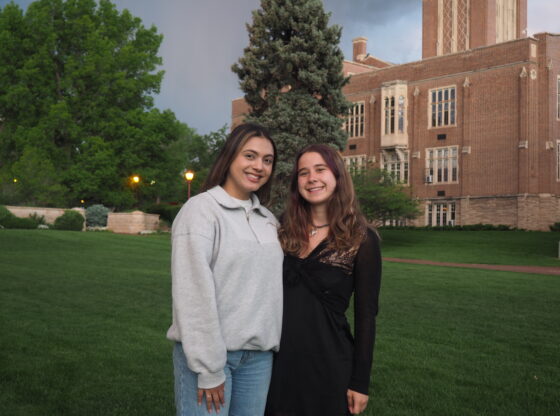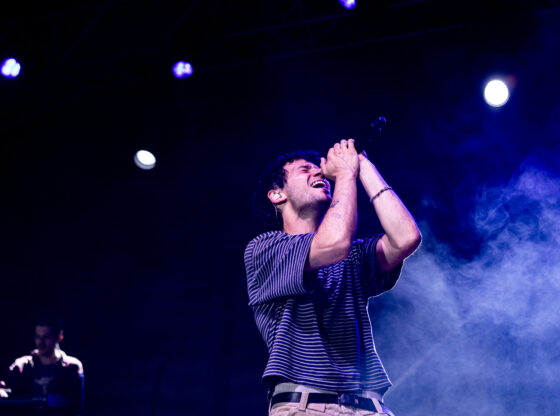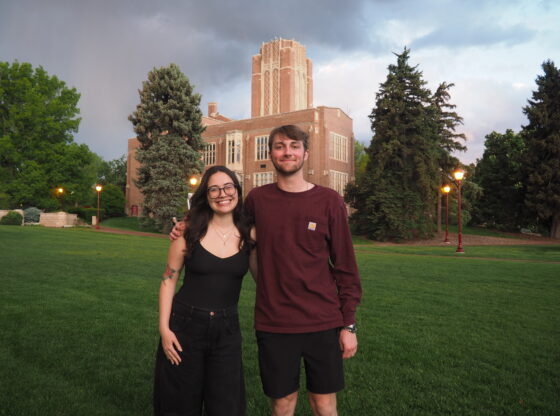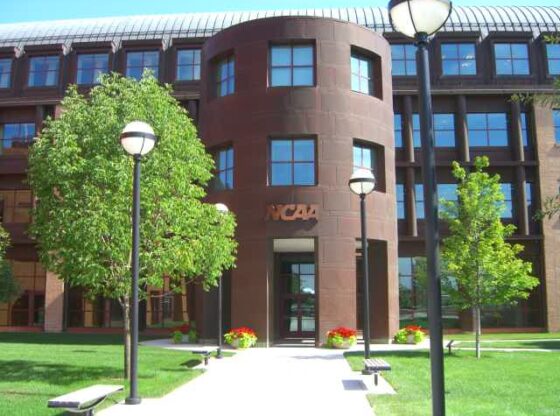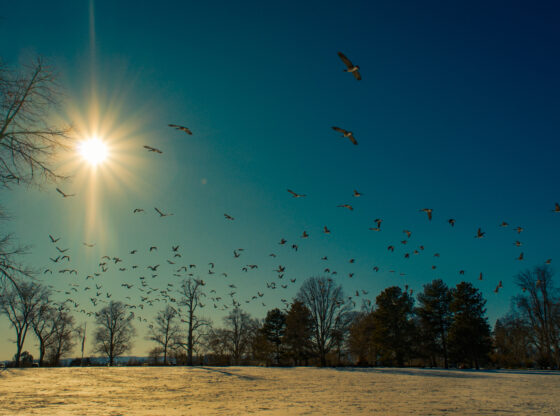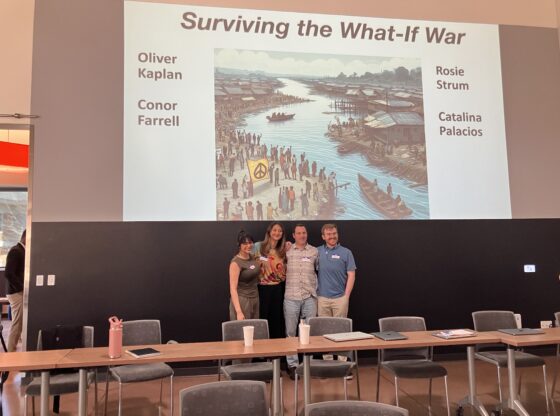The DU While Native project is a five part series, explaining the unique situation Indigenous students are in by attending DU, considering the institution’s history in the Sand Creek Massacre; highlighting the struggles these students face on campus and on their journey through higher education; telling stories of their resistance and survival on campus and more. It serves as a space in which Native students at DU can tell their own stories—stories often shared by many Native students around the country. It serves to educate those outside of the community and give insight to the devastating national statistics about the retention of Indigenous students in higher education. Some students have chosen to use pen names to protect their safety on campus. If you have any questions or comments, please send them to duwhilenative@gmail.com.
I still remember the first professional dinner I attended at DU. The dinner was meant to formally introduce first year students to the university community and to our chancellor, Rebecca Chopp, who gave a speech about the legacy and traditions of our university. I remember the dinner for several reasons. For one, I remember feeling insecure about the dress I was wearing. I had bought it specifically for the event. But my dress was from Goodwill, and everyone around me seemed to me to be wearing something exceedingly fancier. Beautiful dresses and shoes surrounded me, and I was sure they cost more than anything I or anyone in my family had ever owned. Although I can now say that I’ve experienced this feeling of discomfort and insecurity at almost every major event I’ve attended throughout my years at DU, that was the first time I had really felt concerned that I might be judged based on what I was wearing.
What I was wearing and how I felt may have seared that dinner into my memory, but that evening was also memorable for another reason. It marked the first time I heard about the John Evans Report, which would shape my experience at DU for my next four years.
DU’s role in the Sand Creek Massacre

What is the John Evans Report? The report’s history is rooted in the lead-up to the DU’s sesquicentennial, celebrated in the early spring of 2014 at a dinner that looked much like the one I was to attend my freshman year about 18 months later. The event would, of course, recognize John Evans, who was the founder of the university. But Evans had also served as the territorial governor of Colorado and superintendent of Indian Affairs at the time of the Sand Creek Massacre—a massacre in which U.S. soldiers killed over 200 Cheyenne and Arapaho people, most of whom were women, children and elders. Both the massacre and the founding of the university happened within days of each other. And so, in the year before DU’s sesquicentennial celebration, members of DU’s faculty pressed to form a committee to look into the ways that Evans may have been responsible for, or at least culpable in relation to, the Sand Creek Massacre.
The committee—named the John Evans Study Committee—was comprised of professors from various departments at the university, including political science, history, English and more. After a year-long investigation, the committee released the John Evans Report, which concluded that John Evans was culpable for the Sand Creek Massacre.
One of the professors on the committee was Dr. Billy J. Stratton, who is an associate professor in the English department at DU, as well as the special advisor to the chancellor and provost on Native American Partnerships and Programs. He stated that one of the reasons why the John Evans Study Committee was created was because, when he arrived on DU’s campus in 2010, “there seemed very little awareness of the Sand Creek Massacre on campus, and very little awareness of the Cheyenne and Arapaho claims to this land and their previous occupation of it.” He said that although the committee got support from DU’s administration, the report was “completely faculty driven and faculty initiated.”
As to the importance of DU’s role in the massacre, Dr. Stratton said, “I think Sand Creek and DU are inextricably linked together, and always will be.”
While the report found Evans’s actions to be culpable for the massacre, it found Colonel John Chivington, an original member of DU’s board of directors, to be directly responsible for the event. The report states, “We conclude that John Evans’ pattern of neglect of his treaty-negotiating duties, his leadership failures, and his reckless decision-making in 1864 combine to clearly demonstrate a significant level of culpability for the Sand Creek Massacre. While not of the same character, Evans’ culpability is comparable in degree to that of Colonel John Chivington, the military commander who personally planned and carried out the massacre. Evans’ actions and influence, more than those of any other political official in Colorado Territory, created the conditions in which the massacre was highly likely.”

This history of DU’s founders, as analyzed by members of DU’s community, put the university’s Native students in a unique situation: they attend a university whose history is deeply intertwined in a horrific massacre of Native peoples. This history is deeply meaningful for Native peoples, as evidenced in the fact that the Northern Cheyenne, Northern Arapaho and Southern Cheyenne and Arapaho Nations—the nations whose land DU occupies—have long participated in an annual Sand Creek Massacre Spiritual Healing Run to remember and heal from the event. And this history is also deeply meaningful for the Native students attending DU.
When I first heard Chancellor Chopp mention the John Evans report and Evans’s role in the Sand Creek Massacre, I remember trying to reconcile how I, as a Native student, could attend a university whose history is rooted in the genocide of Indigenous peoples. I remember asking myself: by attending DU, am I honoring those ancestors, or am I condoning the university’s past by contributing to DU’s institution in its present?
Other students grapple with this, too. Thus in April of 2018, the Native Student Alliance went on a trip to the Sand Creek Massacre site to respect the ancestors who sacrificed their lives. We left prayer ties—ties filled with tobacco that are crafted as people are praying. Viki Eagle, director of DU’s Native American Community Partnerships and Programs, previous DU undergraduate student, and current graduate student at the Graduate School of Social Work (GSSW), was organizer of the event. She explained, “I wanted to take the students to the site to contextualize their educational experience, and to understand our history at DU. Students here feel like they’re having a hard, miserable time, and Sand Creek contextualizes that. Everything for us starts there. We need to pay respects and realize how privileged we are. For us, it says, yeah, it’s hard, but it has been harder for those who came before us. I think people from Sand Creek would be happy to know that we’re graduating from a school whose history is a part of the massacre. And when I came to DU, I didn’t know about the massacre at all, and I wanted them to know.”
Following the John Evans report, the committee also released a list of recommendations for the university to “illuminate a new path forward… of unity, collaboration, and healing for all communities.” The report lists 22 recommended goals for DU that involve curriculum changes, educational opportunities for Native students, transparency and more. Native students and faculty have worked since 2014 to ensure the university continues to reach these goals.
The university’s recent past

The institution’s recent history relating to Native communities has not been without its problems, either. For 80 years, until the mid-1970’s, DU’s Iliff School of Theology displayed a book that was bound in the skin of a Native person. Until 1998, DU’s official mascot was Boone, a mythologized character based on the real-life experiences of Daniel Boone, who was known as a “pioneer” who murdered thousands of Indigenous people in the Shawnee tribe. Even more recent are the experiences of Viki Eagle and Simon Moya-Smith, previous students at DU.
Viki Eagle still works at the university, but was an undergraduate student at DU from 2008 to 2012. She said, “When I came here, I had the most shocking first year ever. I just hated it here. I just did not like the student body, and if it wasn’t for programs like ELI (Excelling Leaders Institute), I don’t know how I would have done DU.”
She explains that a part of the reason why her four years at DU were difficult was because there was insensitivity towards Native students from other students and groups on campus. Organizations hosted Thanksgiving parties where people dressed up as “pilgrims and Indians,” the homecoming her fourth year was named “How the West was Won” and a fraternity hosted a “Cowboy and Indian” party. At the time, there were around six Native students on DU’s campus, and they worked hard to protest these events and bring awareness about why they were harmful.
Simon Moya-Smith attended DU in the same year as Viki’s fourth year of undergrad, and he also recalls the infamous cowboys and Indians fraternity party that took place on DU’s campus. He said that moment was important to him as a Native student because of how Native students responded. “[The most important time for me as a Native student] was when we called those fuckers out,” he said. “We said, ‘fuck you.’ ‘Cause [it was] right there at DU on the school green, that’s right in front of those frats, so we were like, ‘fuck you, you’re on Indigenous territory and we’re going to remind you of that.’ We erected the teepee and stayed in it for that night and it was freezing. We were cuddling because we had to get close, and we couldn’t obviously light a fire in there. And I think the next day when they finally apologized, I think it was an affirmation of our resiliency rather than their humility. It made it into the Denver Post, and Tink [Iliff Professor Emeritus “Tink” Tinker] spoke at it, and we had a prayer, and it really gathered a lot people because we raised a lot of people by pushing back.”
(See this video for a discussion of the event)
He continued, “And that responsibility for the next generation is coming. If you sit on your lips when you actually should be speaking, you’re kind of setting them up for some shit that’s gonna happen. It’s kind of like domestic violence in that way, it’s kind of like, you’re not the first person he hit, you probably won’t be the last, and if you don’t say something, he’s gonna keep doing it. You gotta say something. We felt that responsibility to push back and say something.”
The alumni who dealt with DU’s recent past not only worked hard to stand up for their community then, but they mentor Native students on campus now. These alumni and their experiences are looked up to by current Native students. Students have responded to Simon’s call and have pushed back against events on campus that affect the Native community. They cried foul when the university hosted the Pipeline Leadership Conference, which included companies like Energy Transfer Partners (ETP) —the company responsible for the Dakota Access Pipeline that tribes were protesting in Standing Rock at the very same time, and the company whose private security detail were paid to harm the Indigenous water protectors.
DU lacks institutional support for Native students
As an institution, there is little support for Native students. While Viki Eagle’s role exists to help support students, currently, DU only has six Native faculty and non-faculty staff members —Eagle and five professors across different departments. Dr. Chris Nelson, professor at Morgridge College of Education, is one of those faculty members and explained that it’s difficult being one of the only few. She said, “I tried doing searches for Native faculty or anything, and I couldn’t find anything, and so, I don’t feel like there was anyone to give me that insider [information]. And so, when I got here and got to know Viki, because she joined at the same time, I was like, what the hell did I just join?”
Dr. Nelson said that while she feels respected within her department, being the only Native faculty in a college can be challenging because, at times, she feels hypervisible—as though she’s supposed to be or act in a certain way. She explained that some of the microaggressions she has faced have been from well-intentioned outreach,and that’s hard to navigate.
Despite the challenges she faces, Dr. Nelson said that being a support system for Native students is valuable for her. She recalled times where she was able to directly support and comfort students through their time at DU and how those times marked significant moments in her career. Likewise, Native students have spoken about how meaningful it is to have Indigenous faculty on campus, even if there are few.
How Native students navigate DU’s history, past and structure
DU’s history is an integral part of Native student’s experience at DU. After I first learned about DU’s founders’ roles in the Sand Creek Massacre at the first-year dinner, I brought it up to my freshman seminar professor in front of our class. I asked, “How could the university not have told their students this before we arrived?” A student in my class—a white male—laughed a little, and said, “Who cares? I don’t really understand how what happened with the Indians is relevant to us, anyway.” A few boys in his corner chuckled with him. The professor said nothing, I said nothing, but my chest felt heavy with sorrow for the ancestors who lost their lives in order for me to be able to learn on the land that belongs to them.
I’m not the only student who didn’t know about DU’s role in the Sand Creek Massacre. Of all the Native students and faculty I have talked to, not one knew about the institution’s connection prior to attending DU. I’m also not the only one who finds it difficult to reconcile coming to a university complicit in genocide of our relatives. But as Viki Eagle said, I can only thank the ancestors who came before me for their sacrifices. I hope that they’d be proud of me for graduating from the institution rooted in their murder and displacement, and I seek to honor them by striving to make the university accountable to being better for Native students and communities.

I also honor the recent experiences of our Indigenous alumni by continuing to do the work they started here at DU: keeping the university and organizations on campus accountable for their actions, standing up for Native issues and creating a safe community for Native students at DU. I rely on the few Indigenous faculty and non-faculty staff members that DU has to support and mentor me through that process.
DU has a deep and complex history with Native communities, and this history affects current Native students, as does the lack of Native faculty at DU. Because of this DU’s history, past and structure affects the way Native students navigate DU, and thus, their higher education experience. The next piece examines these students’ experiences, barriers and hardships while attending the university.


